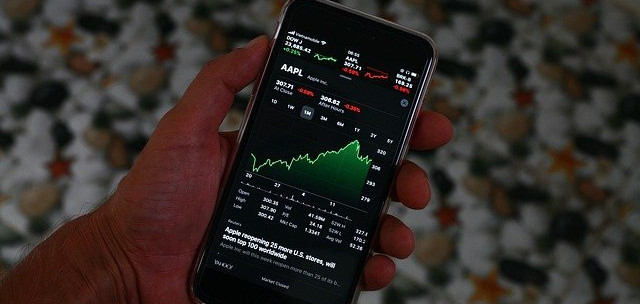What Is Options Trading? How Does It Work?

An option is a contract that allows (but doesn’t require) an investor to buy or sell an underlying instrument like a security, ETF, or even index at a predetermined price over a certain period of time. Buying and selling options are done on the options market, which trades contracts based on securities. Buying an option that allows you to buy shares at a later time is called a “call option,” whereas buying an option that allows you to sell shares at a later time is called a “put option.” However, options are not the same thing as stocks because they do not represent ownership in a company. And, although futures use contracts just like options do, options are considered lower risk due to the fact that you can withdraw (or walk away from) an options contract at any point. The price of the option (its premium) is thus a percentage of the underlying asset or security.
What is options trading?
Options are traded on the options market, a computer-based trading platform. It is akin to a stock market, except that you are trading contracts rather than shares. The most popular contracts traded on the options market are put and call options. The purpose of trading options is to protect a trader against the risk of owning security at a particular price. If you own a call or put option, your trade expires at a certain time. For a call option, this would mean the option goes ex-dividend. You then lose the right to buy the underlying stock or ETF at that price for a given period of time (the “ex-date”).
The Different Types of Options
There are basically four types of options available on the U.S. stock exchange. Two of the – calls and puts – are bought and sold just like regular stocks, but they differ in how they’re constructed. The first one is called the “single” option. It is a naked call option that allows the owner to buy the underlying security at a predetermined price at any time up to the expiry date or expiration date. The only difference between a call option and a put option is that the owner of the option gets the right to buy the security at the expiration date. The second type is called the “divided” option. It is a stripped naked put option that requires the investor to buy and then simultaneously sells 100 shares at a fixed price per share at any time up to the expiry date.
What is a call option in stocks?
A call option gives you the right to buy shares at a certain price over a certain period of time. For example, if you are looking to buy shares of a company and you get a call option, you will receive a $30 strike price. As long as the company keeps the shares above $30, you will be able to sell the option anytime you want to. A call option is a contract that gives you the right to purchase shares of a company at a certain price (usually between $1.00 and $5.00 a share), at a certain date in the future. In the same way, you buy a stock that gives you the right to buy a company’s stock at a predetermined price, you can also sell a call option to someone else who will buy it at that predetermined price. In other words, you buy an option and ask someone to purchase it from you.
What is a put option in stocks?
With a put option, you can take a bet that a stock will decline in value over a certain period of time. A put option entitles you to purchase a stock for a given price at a later time. If the share price is above that price, then the investor receives the money back. But if the share price drops below the put price, then the investor loses the entire amount they invested and the stock is not delivered.
How does options trading work?
Options trading involves multiple scenarios. As an example, you may want to use options in your account when an ETF you own goes on a deep, multi-day decline. In this situation, you may want to sell calls on your position and receive a “cash-out” for selling the shares you would have otherwise owned. The strategy can help you keep the premium you receive on stock for an extra week or two if the underlying ETF keeps falling in value. Another scenario might involve selling an out-of-the-money call option on a stock that you don’t own at a large premium to the share price. Your premium can be used to buy shares in the company, if they go on a crash of any kind, at a discounted price.
This post contains affiliate links. Please please read my Disclaimer for more information
Why should you consider options trading?
Because you can create an excellent risk-adjusted return, and, more importantly, have more control over the price at which you’re going to get out of your position. Options are great if you want to take a bet on the price of a stock going down while being able to buy the stock at a cheaper price than it would be trading for at the open.
What are the options trading terms?
Options trading terms vary by contract but are usually explained in simple terms below: Selling: When an investor buys an option to sell the underlying security (like a call option). This will only be done if the underlying security is above the strike price (the price you agree to pay for the underlying security) and you’re willing to sell at that price in the future. This means you can only sell your option if you want to. When an investor buys an option to sell the underlying security (like a call option). This will only be done if the underlying security is above the strike price (the price you agree to pay for the underlying security) and you’re willing to sell at that price in the future. This means you can only sell your option if you want to.
How Options Pricing Is Determined
Options are priced in two steps: The first step is determining the price range that options are offered for trading, typically ranging between $0.01 and $0.50 per option. The second step is determining the number of contracts that will be sold based on the historical data on demand. The formula for determining the price range is as follows: (Price of the underlying stock when the contract is purchased) + (Length of the option contract) The length of time that the contract will remain open can be calculated by multiplying the time that the contract was open times the strike price, which is the price at which the contract will be settled.
Advantages and Risks of Trading Options
If you’re willing to accept the risks involved, you can make money trading options. However, most people don’t know how to do this. The reason is that options trading is not just a matter of picking the right option contract. The risks are real and can ruin your trading experience, and it can also harm your overall portfolio if you are not careful. For example, a call option is not risk-free because it gives the buyer the right to buy the underlying security at a certain price by a certain time. But if the price moves above or below the strike price, the buyer could make or lose a lot of money. So, the options are not risk-free. Another risk is the underlying stock’s volatility. If the stock price moves beyond a certain threshold, the buyer could lose a lot of money.

Conclusion
Options have traditionally been viewed as too risky for investors and too risky for small investors, but they are certainly gaining traction among investors. The popular trend of volatility in stocks has taken many by surprise as they speculate on price swings and this has brought more trading activity to the options market. Ultimately, investors should decide for themselves whether options are right for them.
“If you have any feedback about what is options trading that you have tried out or any questions about the ones that I have recommended, please leave your comments below!”
NB: The purpose of this website is to provide a general understanding of personal finance, basic financial concepts, and information. It’s not intended to advise on tax, insurance, investment, or any product and service. Since each of us has our own unique situation, you should have all the appropriate information to understand and make the right decision to fit with your needs and your financial goals. I hope that you will succeed in building your financial future.
Leave a Reply